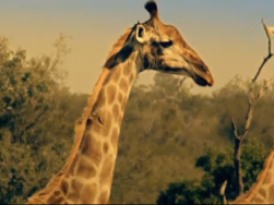A Diet of Cellulose
So the termites deal with most of the lignin, but that still leaves a vast store of carbon in the form of cellulose.

Across Africa, herds of mammals graze on grasses and leaves, turning the cellulose into meat. Many are a type of mammal known as a ruminant… the largest of which is one of the easiest animals to spot on safari. Giraffes live off a diet similar to termites. They eat cellulose. primarily the tops of the acacia trees that you see scattering the African Savannah.
And they face that same problem, they’ve got to break those difficult carbon bonds down and they’ve come up with a very similar solution which is to cultivate bacteria and fungi. But they do it inside the stomach’s and ruminants like giraffes have had to build a very complex system in order to do that.
They’ve got four stomachs, one of them contains the culture of bacteria and fungi, that allow them to digestive that difficult cellulose. Even with all this hardware, ruminants must feed for over two thirds of the day. But there are other creatures here that have found a shortcut, after all, if plant fibres are hard to digestive, why not let someone else do the work and simply steal a meal?
Look what we’ve just found. We were out looking for giraffe this morning, and we found about ten of them over there, but in looking for the giraffe, we’ve just found a leopard. This is one of the top predators out here. He’s got very little to fear apart from other leopards and maybe lions. He’s around two years old and at the moment, he doesn’t have his own territory, he’s too young for that. So he’s lying low. He’ll have to make about two kills a week to stay in good condition. So, maybe he’ll catch an Impala every 3 to 4 days, and is obviously doing that. Because, look at him! He’s looking for protein, and I’m a little worried because I’m protein!
Carbon Cycle
From its origin in the death of stars… its capture by plants… through insects, mammals and on. The carbon cycle is the real circle of life. Out there tonight, the relentless recycling of carbon through the food chain will continue. As night falls, you can almost sense it – the change in the sounds and the atmosphere. Some will die, so that others can live, as carbon leaps from branch to branch across the great tree of life. And helping it along its way is just one very special form of chemistry. Every living thing is just a temporary home for carbon atoms that existed long before there was life on Earth and will exist long after Africa and Earth are gone. But, the pattern of life, the information needed to build a zebra or a tree, or a human being or a lion persists. It’s passed on from generation to generation, in a molecule. A helical molecule with a backbone of carbon called DNA.
There was a time when Earth appeared empty. Yet despite appearances, 3.8 billion years ago life was already underway, in the form of tiny living specks that probably all shared the same biochemistry. We know that every living thing on the planet today – so every piece of food you eat, every animal you’ve seen, everyone you’ve ever known or will know, in fact every living thing that will ever exist on this planet – was descended from that one speck. We call it the last universal common ancestor, or LUCA. So, just as the universe had its origin at the Big Bang, all life on this planet had its origin in that one moment.
Less than a billion years after its formation, there was already life on Earth. It’s possible that some of it used biochemistry utterly different from the life we see today. If so, it has long been extinct. It’s also possible that the first life may not have been cellular – just living chemistry in the porous rocks of some ancient ocean. We are not sure, but what’s certain is that one day, a population of organisms showed up with biochemistry that we would recognise. This was LUCA.
The first expression of a form of life that would in time throw up a group of humans who left their mark on this part of Africa.
External Links
Why do you need cellulose in your diet? – LiveStrong.com
